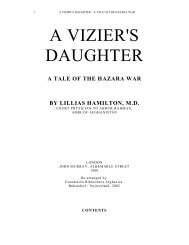The Inquiry into the History of the Hazara Mongols of ... - Hazara.net
The Inquiry into the History of the Hazara Mongols of ... - Hazara.net
The Inquiry into the History of the Hazara Mongols of ... - Hazara.net
Create successful ePaper yourself
Turn your PDF publications into a flip-book with our unique Google optimized e-Paper software.
HAZARA MONGOLS 241<br />
Following <strong>the</strong> death <strong>of</strong> Shah Rukh's successor in 1447, <strong>the</strong> capitol <strong>of</strong> <strong>the</strong><br />
greatly reduced Timurid domain was returned to Samarkand, and central Af-<br />
ghanistan returns to historical obscurity until <strong>the</strong> beginning <strong>of</strong> <strong>the</strong> sixteenth<br />
century, when <strong>the</strong> Timurid price Babur invaded Afghanistan and established<br />
his capitol at Kabul. By that time <strong>the</strong> <strong>Hazara</strong> <strong>Mongols</strong> were a distinct people,<br />
dwelling in much <strong>the</strong>ir present habitat.<br />
<strong>The</strong> foregoing resume <strong>of</strong> Mongol history in Afghanistan shows that <strong>the</strong><br />
traditional statement made by modern writers concerning <strong>the</strong> origin <strong>of</strong> <strong>the</strong><br />
<strong>Hazara</strong>s is incorrect. <strong>The</strong> available evidence indicates that while several expedi-<br />
tions were made <strong>into</strong> Afghanistan by <strong>the</strong> armies <strong>of</strong> Chinggis Khan, <strong>the</strong> troops<br />
withdrew again as soon as <strong>the</strong> object <strong>of</strong> <strong>the</strong> campaign had been accomplished.<br />
<strong>The</strong>re is no suggestion that Chinggis Khan himself left any permanent garrisons<br />
in <strong>the</strong> region, although he may have paved <strong>the</strong> way for future Mongol settlement<br />
by killing <strong>of</strong>f part <strong>of</strong> <strong>the</strong> former population <strong>of</strong> <strong>the</strong> mountain area.1<br />
<strong>The</strong> region now known as <strong>the</strong> <strong>Hazara</strong>jat seems to have been peopled chiefly<br />
by Chagataians from Transoxiana. O<strong>the</strong>r <strong>Mongols</strong>, and some Turks or Turco-<br />
<strong>Mongols</strong> may have joined <strong>the</strong>se Chagataians. Troops stationed in Khorasan by<br />
<strong>the</strong> Ilkhans revolted against <strong>the</strong>ir monarch on more than one occasion,2 and<br />
it is possible that some <strong>of</strong> <strong>the</strong>se rebels sought refuge in <strong>the</strong> central mountains<br />
<strong>of</strong> Afghanistan, where <strong>the</strong>y could more easily avoid possible punitive expeditions.<br />
Later, under Timur and his son Shah Rukh, troops and administrative <strong>of</strong>ficials<br />
were sent <strong>into</strong> <strong>the</strong> area, and it is probable that some <strong>of</strong> <strong>the</strong>se remained when<br />
<strong>the</strong> Timurids returned to Samarkand.<br />
Thus it would appear that <strong>the</strong> present <strong>Hazara</strong> <strong>Mongols</strong> are descended, not<br />
from military garrisons planted by Chinggis Khan, but from Mongol troops,<br />
many <strong>of</strong> <strong>the</strong>m Chagataian, who entered Afghanistan at various times during<br />
<strong>the</strong> period from 1229 to about 1447 AD.<br />
THE EVOLUTION OF THE HAZARAS AS A PEOPLE IN AFGHANISTAN<br />
When <strong>the</strong> Emperor Babur invaded Afghanistan at <strong>the</strong> beginning <strong>of</strong> <strong>the</strong><br />
sixteenth century, <strong>the</strong> <strong>Hazara</strong> <strong>Mongols</strong> were a distinct people, dwelling in<br />
approximately <strong>the</strong>ir present habitat. In order to understand <strong>the</strong> evolution <strong>of</strong> <strong>the</strong><br />
<strong>Hazara</strong> tribes, it will be well to consider briefly <strong>the</strong> organization <strong>of</strong> Mongol<br />
armies and <strong>the</strong> terminology <strong>of</strong> <strong>the</strong> military units.<br />
<strong>The</strong> Mongol armies were organized <strong>into</strong> units <strong>of</strong> tens (arban), hundreds<br />
(ja'iin), thousands (minggan), and ten thousands (tiiman).3 <strong>The</strong> tiiman, or<br />
61 See above, page 235, footnote 27.<br />
62 Browne, op. cit., p. 176.<br />
63 B. Vladimirtsov, Le Regime Social des <strong>Mongols</strong> (Paris, 1948), p. 134.



